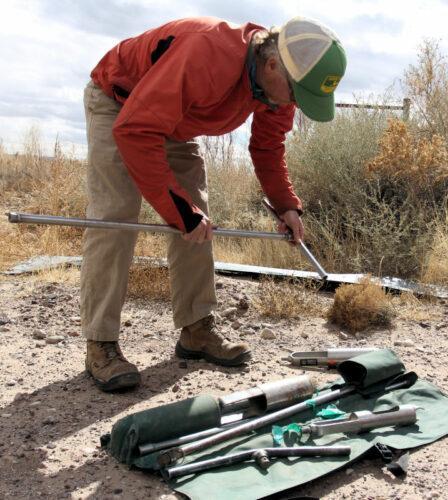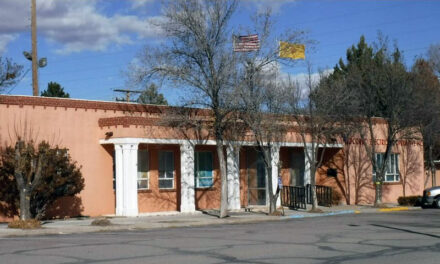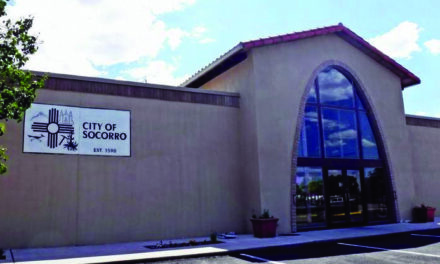
Two Intera employees measure to determine where they will take samples at the Eagle Picher Carefree Battery Superfund Site.
Cathy Cook | El Defensor Chieftain
The Eagle Picher Community Advisory Group (CAG) had its monthly meeting on February 10 with the Environmental Protection Agency’s Nicole Foster, Remedial Project Manager for the superfund site. Foster reiterated at the meeting that Eagle Picher, along with one other superfund site in New Mexico is on the priority panel.
“At this point, we need to make sure the design is still solid and that the conditions at the site are as we left them, or if there are any areas of the design that could need modification,” Foster said.
Although the cost was originally estimated to be in the neighborhood of $16 million, she could not speculate on an exact figure, but pointed out that some of the sites on the panel were much worse than Socorro and would cost hundreds of millions, and others for just “a couple of million.”
She said the process is not based on the cost of the remedy, but rather on making sure the remedy plan is sound. With that being said, the Eagle Picher site could have a price tag as high as $20 to $30 million to clean up.
“New Mexico contractors are reviewing the design and looking at the information that we have right now, discussing where monitoring wells need to be placed,” Foster said. “Just to make sure we do have a very clear picture and then look at the disposal options we have on the design right now.”
She said it was imperative the site be shovel-ready when the funds are allocated.
Foster also responded to a request from 2nd District US Rep. Yvette Herrell to commit to a date to begin remediation.

Getting ready to take samples.
Cathy Cook | El Defensor Chieftain
“Recognizing that it comes from a member of Congress, I have drafted a response to that and it’s going back up through the management team,” she said. “We will be receiving some bipartisan funding for the site that will advance our cleanup on it. At this point, right now, we don’t have the funds, so we are looking at having them obligated by the end of this fiscal year. For the government, that is September to start construction soon thereafter. But in terms of a date, no, we do not have the date. We are not quite there yet just in terms of not having the funding in place to be able to get contractors at this point.”
She said the EPA is working with the New Mexico Environment Department on a Cooperative Agreement, “and they are working on drafting on their side of it in terms of the work plan and that will provide funding to New Mexico to get the contract in place for construction work.”
She said construction companies customarily want to have the money “before we schedule them on the books.”
In the meantime, Eagle Picher saw some activity last week. The New Mexico Environment Department’s environmental services contractor began conducting preliminary waste characterization sampling on the property on February 17. According to NMED’s Matthew Maez, samples were collected from soil and building materials and analyzed for lead, asbestos-containing building materials, and lead-based paint.
“The purpose of the sampling is to determine the amount of hazardous materials that will need to be sent to specialized disposal facilities,” Maez said in an email. He said NMED is working closely with the EPA to prepare the site for remedial activities.
“The Environmental Protection Agency and NMED are in the process of allocating funds from the Bipartisan Infrastructure Law to this site,” Maez said. “We expect this funding to be awarded to the project this year, and work will begin soon after. Once the funding is awarded, we will have a better sense of the remediation timeline.”
The upcoming work on source area and groundwater cleanup will be performed by a state environmental services contractor under contract with NMED.
“This work will be performed directly under NMED management in consultation with and under the oversight of the EPA,” he said. “Aside from overseeing the work, NMED ensures the work is performed correctly from scientific and technical aspects. We also review the data to ensure clean-up progresses correctly.”
The Eagle Picher Superfund Community Advisory Group meets on the second Thursday of the month.


















